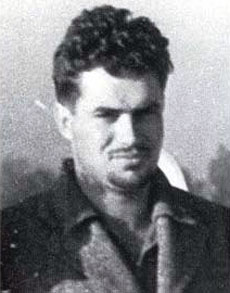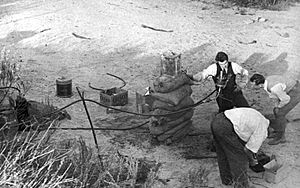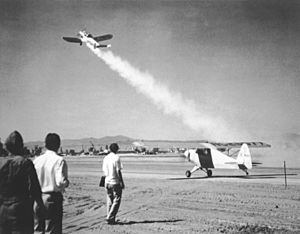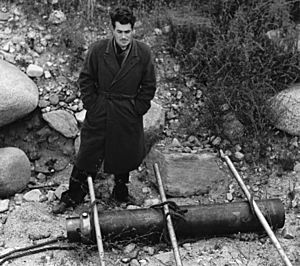Jack Parsons facts for kids
Quick facts for kids
Jack Parsons
|
|
|---|---|

Parsons in 1941
|
|
| Born |
Marvel Whiteside Parsons
October 2, 1914 Los Angeles, California, U.S.
|
| Died | June 17, 1952 (aged 37) Pasadena, California, U.S.
|
| Cause of death | Explosion |
| Resting place | Mojave Desert |
| Other names | John Whiteside Parsons |
| Alma mater |
|
| Occupation |
|
| Organization |
|
| Spouse(s) |
|
John Whiteside Parsons (born Marvel Whiteside Parsons; October 2, 1914 – June 17, 1952) was an American rocket engineer and chemist. He helped start important organizations like the Jet Propulsion Laboratory (JPL) and Aerojet Engineering Corporation. Parsons invented the first rocket engine that used a special kind of solid fuel. He also helped develop both liquid-fuel and solid-fuel rockets.
Contents
Early Life and Rocket Dreams
Marvel Whiteside Parsons was born on October 2, 1914, in Los Angeles, California. His parents divorced soon after he was born. His mother started calling him John, but many friends knew him as Jack.
Jack grew up in a wealthy home in Pasadena, California. He had few friends and spent a lot of time reading. He loved stories about mythology, Arthurian legend, and the Arabian Nights. Reading Jules Verne and Amazing Stories got him interested in rocketry.
School Years and Early Experiments
At age 12, Parsons went to Washington Junior High School. He struggled in school, possibly due to dyslexia, and was bullied. However, he became good friends with Edward Forman, who shared his love for science fiction and rockets.
In 1928, Jack and Edward started experimenting with homemade rockets. They used gunpowder and fireworks. They even used glue to make the rocket fuel more stable. Their experiments left craters in Parsons' family garden!
Parsons later attended the University School, where he did much better in his studies. He became editor of the school newspaper. Teachers from the California Institute of Technology (Caltech) helped him focus on chemistry.
While working at the Hercules Powder Company, Parsons learned more about explosives. He and Forman kept building and testing rockets. They even wrote to famous rocket pioneers like Robert H. Goddard and Wernher von Braun. Parsons and von Braun had long phone calls about their rocket research.

Parsons finished high school in 1933. He tried to study chemistry at Pasadena Junior College and Stanford University, but he had to drop out due to money problems.
Forming the GALCIT Rocket Research Group

In 1934, Parsons, Forman, and Frank Malina formed the GALCIT Rocket Research Group. GALCIT stands for Guggenheim Aeronautical Laboratory. They got support from Theodore von Kármán at Caltech.
The group wanted to develop rockets for space travel. They didn't tell everyone this at first, because many scientists thought it was just science fiction. Caltech allowed them to use their equipment.
Parsons was the chemist, Forman was the machinist, and Malina was the expert in rocket theory. Their first test of a liquid-fuel rocket happened in 1936. After some tries, they successfully fired a rocket in January 1937.
Advancing JATO and Founding Aerojet
In 1939, the GALCIT Group received money to work on Jet-Assisted Take Off (JATO) for the U.S. military. JATO rockets help planes take off faster.
Parsons invented a solid JATO fuel using special chemicals. The first JATO tests with a plane happened in 1941. The rockets helped planes take off faster, but sometimes they exploded.
Eventually, they found the right mix of chemicals for the fuel. This new fuel was much more powerful. In 1942, the group formed the Aerojet Engineering Corporation to produce and sell JATO engines to the U.S. Army Air Corps.
Parsons kept improving the fuel. He invented GALCIT-53, which was very stable and powerful. Later versions of Parsons' solid-fuel design were used by NASA in Space Shuttle Solid Rocket Boosters and in military missiles.
Founding JPL

As the U.S. learned about Germany's V-2 rocket, the military gave the group a large grant to develop rocket weapons. The group grew and was renamed the Jet Propulsion Laboratory (JPL). Parsons left JPL and Aerojet in 1944.
Personal Life
Parsons was known for being a bit unusual. He sometimes greeted guests with a large pet snake around his neck. He also used a mannequin dressed in a tuxedo as his mailbox. He enjoyed fencing, archery, and playing pranks on his friends.
Parsons married Helen Northrup in 1935. They later divorced in 1946. He then married Marjorie Cameron, an artist and actress, in October 1946.
Death
Parsons died in 1952 at age 37. He was killed in an explosion in his home laboratory. The police said it was an accident. His ashes were scattered in the Mojave Desert.
Legacy and Impact
Even though his scientific work wasn't always recognized at first, historians now see Parsons's important contributions to rocket engineering. He helped start JPL and Aerojet, and he supported space exploration and human spaceflight. Because of this, Parsons is considered a very important person in the history of the U.S. space program.
His life has been featured in several books and TV shows. In 2017, a web TV series called Strange Angel was made about Parsons's life. He has also been the subject of musical tributes.
Patents
- U.S. Patent 2,484,355, Aerojet 1945. Reaction motor with propellant charge mounted in it.
- U.S. Patent 2,563,265, Aerojet 1943. Rocket motor with solid propellant and propellant charge therefor.
- U.S. Patent 2,573,471, Aerojet 1943 with Frank J. Malina. Reaction motor operable by liquid propellants and method of operating it.
- U.S. Patent 2,693,077, 1944/1950 with Frank J. Malina. Reaction motor operable by liquid propellants and method of operating it.
- U.S. Patent 2,771,739, Aerojet 1953 with Frank J. Malina. Rocket propulsion method.
- U.S. Patent 2,774,214, Aerojet 1954 with Frank J. Malina, 1954. Rocket propulsion method.
- U.S. Patent 2,783,138, Aerojet 1944. Propellant compositions.
Images for kids
-
The modern logo of the Jet Propulsion Laboratory
-
Parsons is credited for inventions used in rocket technology such as the Space Shuttle.
See also
 In Spanish: Jack Parsons para niños
In Spanish: Jack Parsons para niños






